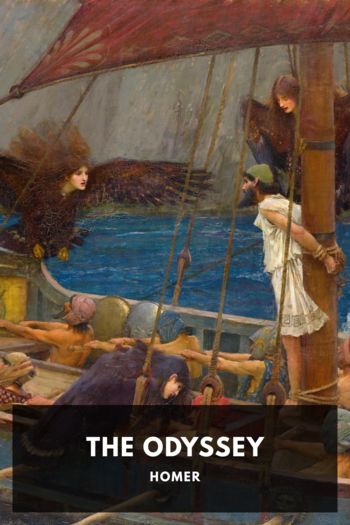The Bootlegger, Clive Cussler [black books to read TXT] 📗

- Author: Clive Cussler
Book online «The Bootlegger, Clive Cussler [black books to read TXT] 📗». Author Clive Cussler
He asked to speak with the engineer, but the man was out on another train. The locomotive’s fireman was “around somewhere,” but neither in the freight house, where large items were stored, nor in the express house, which handled packages. “Try the engine house.” Skirting piles of sand and gravel and a clamshell bucket loading hopper cars, Bell found the fireman oiling a 4-6-0 and asked if he had a look at the boat.
“What boat?”
“On the flatcar.”
“Is that what it was? It was wrapped under canvas. Sure, could have been a boat, I suppose.”
“Didn’t you wonder?”
“Weren’t about to ask. They were a tough bunch.”
“How many men?”
“Six or seven, I believe. They holed up in the caboose, made the brakeman ride up in the cab with me and the engineer.”
“Where’d you take it?”
“I rode as far as Jamaica.”
From the Long Island Railroad’s central freight junction at Jamaica, in the New York City borough of Queens, car number 55461 had been sent to the East New York freight yard. From East New York, it was shunted to the waterfront Bay Ridge Terminal and rolled onto a car float. A Pennsylvania Railroad tugboat shepherded the car float across the Upper Bay to Jersey City’s Greenville Terminal, where 55461 disappeared.
Bell made a contribution to the railroad police “benevolent fund” and blanketed the yard with his own detectives to search for it. But it was nowhere on the property. Nor did the Pennsylvania Railroad have any record of the flatcar heading south or west on “Pennsy” track.
An angry Isaac Bell stormed that a flatcar carrying a seventy-foot speedboat, covered in canvas or not, could not simply vanish. A frightened dispatcher finally admitted that shortly after the car had arrived at Greenville, someone had lifted some papers from the chief dispatcher’s files. Bell recalled from Grady Forrer’s report that, when penetrating a foreign nation, the Comintern routinely infiltrated railroads and dockyards with low-level agents.
“What would happen,” he asked the Greenville dispatcher, “if flatcar 55461 had continued down the line with no record of its existence?”
“That would have caused great confusion and immediate consternation.”
Bell sent his men on a search for what competing railroad line the flatcar might have been transferred to. They picked up the trail nearby in Jersey City at the Weehawken junction. Number 55461 had been coupled to a New York Central freight train. The New York Central freight had headed north on the Central’s West Shore Division, which meandered four hundred twenty-five miles from Weehawken, New Jersey, to Buffalo, New York.
Isaac Bell sent detectives after the freight. But with a fair idea of Black Bird’s ultimate destination forming in his mind, Bell himself raced to the Delaware, Lackawanna and Western’s Hoboken Terminal. The Phoebe Snow, a high-speed passenger limited, whisked him straight to Buffalo.
• • •
THE BUFFALO YARDMASTER at the New York Central West Shore Division Terminal told Bell the freight train had already been broken up. Some of the cars had unloaded in Buffalo and some were dispersed to other railroads. “A boat, you say?”
“Under canvas.”
“Well, if it was a boat, go talk to the Buffalo Creek Railroad. They switch cars to the waterfront.”
Bell hitched a ride on a Buffalo Creek switching engine, a little 0-6-0, that pushed a string of empty hopper cars back to the waterfront, where giant bulk carriers from the Midwest were moored to grain elevator docks. The engineer dropped the last empty, and the little engine huffed a few hundred yards to the end of the line. The rails stopped beside a crane on the edge of Lake Erie.
“Dropped him right here.”
The engineer lit a cigarette. Bell climbed down beside the murky water and stared west.
“A boat,” said the engineer, “can go anywhere from here.”
“Detroit.”
“Anywhere. The Great Lakes are all connected. It could be Detroit. Could be Chicago, Milwaukee, even Duluth—though I don’t know who’d want to go to Duluth—Cleveland, Toledo, or even up Lake Ontario to Toronto.”
“Detroit,” said Bell.
The ingredients for three of every four drinks consumed in America were smuggled across the Detroit River. Where else could Marat Zolner and his Black Bird be but Detroit? Bell was sure it was Detroit. But he was less sure why.
The Van Dorn Detective Agency had bloodied his nose in New York, taking his Long Island estate and his bottling plant in Lower Manhattan. Had Zolner fled to Detroit? Or did he already have New York in the bag, despite a bloody nose, and had gone to Detroit to expand his empire?
• • •
“GOOD LUCK,” a Canadian stevedore at the liquor export dock muttered as the long black whisky hauler rumbled into the dark. “You’ll need it when the Purple Gang hears you coming a mile away.”
He and his mates were placing bets. The new boat, which had taken on a full thousand cases of Canadian Club, made a hell of a racket. Who would catch it first? Customs picketboats? Or the hijackers? The hijackers were the favorites. Side bets were placed on the notoriously vicious River Gang. The smart money inclined toward the rival Purple Gang, dubbed “monstrous” by a newspaperman whose head was found soon after floating in Lake Erie.
Any whisky hauler with any brains at all used mufflers. And if the black boat’s noise didn’t cut its odds to near zero, it was nowhere as fast as it looked. The newcomers had overloaded it. Crossing a stretch of river where a whisky hauler’s only friends were speed and stealth, it rode low in the water, its engines laboring, at the pace of a steamer on a Sunday school outing.
• • •
THE RIVER GANG BOSS, “St. Louis Pete” Berelli, son of Sicilian immigrants, had grown up in a Jewish slum. Initiated as a boy into the neighborhood’s exceptionally violent street gang, Berelli had nothing against the Jews. Until he hauled





Comments (0)